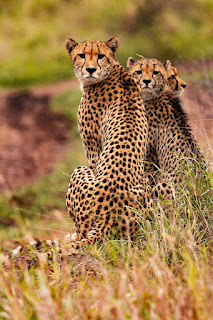The Elephant in the Room: How Overpopulation Is Threatening Tourism in Africa
Africa has long been considered the top destination for tourists seeking authentic and adventurous travel experiences. Its breathtaking landscapes, diverse wildlife, and vibrant cultures are a dream come true for many a traveler. So much so that, in fact, even the most discerning travelers, in one way or another, find African safaris appealing.

However, amidst the allure of Africa’s natural wonders, the continent is grappling with an issue that often flies under the radar: overpopulation. For many, overpopulation might seem counterintuitive considering Africa’s vast expanses. However, it manifests itself in various ways that significantly impact the tourism sector.
The phenomenon is particularly evident in regions renowned for their safari experiences. Countries such as Kenya, Tanzania, and South Africa, celebrated for their rich biodiversity and extensive game reserves, are now facing the challenge of managing large human populations alongside their wild counterparts. But, how exactly has overpopulation threatened tourism in Africa? That’s the elephant in the room, and we dare to address it today.
The Wildlife Conundrum
One of Africa’s biggest draws is its rich biodiversity. The continent is home to all sorts of wild animals, from the majestic elephants of the savannas to the elusive leopards in the dense jungles. However, the surge in human population has posed a direct threat to the natural habitats of these animals.
To put this into perspective, in 2023, it emerged that about 23,000 hectares of Maasai Mau Forest had been encroached on, thus threatening the survival of numerous species dependent on this vital water catchment land. Furthermore, across Africa’s continent, expanding urban areas, agricultural development, and infrastructure projects have encroached upon the once-untouched wilderness, leading to habitat loss and fragmentation. Not only has this endangered the wildlife but it has also weakened the allure of Africa’s previously untamed beauty that was once the cradle of humankind.

The Battle for Resources
With a rapidly growing population, African nations are grappling with the increased demand for resources such as water, land, and energy. In many cases, local communities are forced to exploit natural resources to sustain their livelihoods, often resorting to activities like deforestation, overfishing, and illegal wildlife poaching. The resulting environmental degradation has harmed the delicate ecosystems and undermined the appeal of destinations that once boasted pristine natural beauty.
Strain on Infrastructure
The surge in population has also put immense pressure on infrastructure in many African countries. From overburdened transportation systems to crowded tourist sites, the strain on facilities has caused a rapid decline in the overall visitor experience. Inadequate waste management and sanitation facilities have further contributed to environmental degradation, impacting the attractiveness of destinations for tourists seeking a clean and well-maintained environment.
Cultural Impact
The impact of overpopulation goes beyond the natural aspects of tourism. In Africa, it has cultural ramifications, too. Increased population density often leads to urban sprawl, resulting in the loss of traditional villages and cultural heritage sites. As cities expand to accommodate the rising numbers, the unique charm and authenticity that once drew travelers to experience Africa’s rich cultural diversity continues to be eroded.
Sustainable Solutions
As it turns out, it’s not all doom and gloom for Africa’s tourism sector. In the face of these challenges, the continent can tap into sustainable solutions and continue to captivate travelers while preserving its unique natural and cultural heritage.
Addressing the challenges posed by overpopulation requires a multi-faceted approach. Governments, local communities, and the tourism industry can collaborate to implement sustainable solutions that balance population growth with environmental and cultural preservation. Below are sustainable practices the continent should embrace to open the door to a brighter future:
Embracing Conservation Efforts
Increased investment in conservation projects, national parks, and wildlife reserves can help protect crucial habitats and safeguard endangered species. Furthermore, adopting cutting-edge technology, such as drones and satellite monitoring, can aid in the tracing and protection of wildlife. Strict regulations and penalties for illegal activities like poaching are also essential to deter those who threaten wildlife.
Community Involvement and Empowerment
Local communities play a pivotal role in the success of conservation efforts. Involving local communities in tourism planning and management ensures that their voices are heard and their needs are addressed. Empowering residents with employment opportunities in eco-tourism and related fields can also strengthen the connection between communities and the natural resources they’re working to protect, fostering a shared commitment to preserving natural and cultural assets.
Promoting Sustainable Tourism Practices
Encouraging responsible tourism practices is paramount to ensuring that the industry contributes positively to environmental and cultural conservation. This involves setting and enforcing guidelines for tour operators and visitors alike. Limiting the number of tourists in sensitive areas, promoting low-impact activities, and educating visitors about the importance of respecting local customs and wildlife habitats are critical components of sustainable tourism.
Similarly, certification programs, such as the Global Sustainable Tourism Council’s (GSTC) criteria, can be implemented to recognize and promote businesses that adhere to sustainable practices. These certifications not only provide a framework for responsible tourism but also act as a marketing tool, attracting environmentally conscious travelers.
Infrastructure Development
Thoughtful infrastructure development is essential to accommodate the needs of a growing population while minimizing the environmental impact. Sustainable practices, such as eco-friendly construction and renewable energy sources, can help strike a balance between development and preservation.

Population Management
When push comes to shove, population management can come in handy. Implementing responsible family planning programs and educating communities about the consequences of overpopulation can help address the root cause of many issues. Collaborative efforts between governments, NGOs, and international organizations are vital to ensuring the success of such initiatives.
Wrapping Up
The challenges posed by overpopulation in Africa are undeniable, and their impact on tourism cannot be ignored. However, with concerted efforts to implement sustainable practices, promote conservation, and engage local communities, Africa can navigate the delicate balance between population growth and preserving the natural and cultural treasures that make it an enchanting destination. The key lies in recognizing the elephant in the room and working collaboratively to ensure the long-term viability of tourism in this awe-inspiring continent

